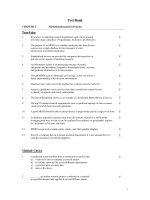Lecture Marketing research (12th edition) - Chapter 17: Hypothesis testing: Basic concepts and tests of association
Bạn đang xem bản rút gọn của tài liệu. Xem và tải ngay bản đầy đủ của tài liệu tại đây (980.16 KB, 28 trang )
1
Marketing Research
Aaker, Kumar,
Leone and Day
Twelfth Edition
Instructor’s
2
Chapter Seventeen
Hypothesis Testing:
Basic Concepts and Tests of
Association
Marketing Research 12th Edition
3
Hypothesis Testing: Basic
Concepts
•
•
Assumption (hypothesis) made about a population
parameter (not sample parameter)
Purpose of Hypothesis Testing
▫
•
To make a judgment about the difference between two sample
statistics or between sample statistic and a hypothesized
population parameter
Evidence has to be evaluated statistically before arriving
at a conclusion regarding the hypothesis.
▫
Depends on whether information generated from the sample is
with fewer or larger observations
Marketing Research 12th Edition
4
Hypothesis Testing
•
•
•
The null hypothesis (Ho) is tested against the
alternative hypothesis (Ha).
At least the null hypothesis is stated.
Decide upon the criteria to be used in making
the decision whether to “reject” or "not reject"
the null hypothesis.
Marketing Research 12th Edition
5
Hypothesis Testing Process
Problem Definition
Clearly state the null and alternative
hypotheses
Choose the relevant test and the
appropriate probability distribution
Determine the
significance level
Compute relevant
test statistic
Choose the critical value
Determine the
degrees of freedom
Decide if one-or twotailed test
Compare test statistic & critical value
Does
the test statistic
fall in the critical
region?
No
Do not reject null
Yes
Reject null
Marketing Research 12th Edition
6
Basic Concepts of Hypothesis
Testing
Three Criteria Used To Decide Critical Value
(Whether To Accept or Reject Null Hypothesis):
•
Significance Level
•
Degrees of Freedom
•
One or Two Tailed Test
Marketing Research 12th Edition
7
Significance Level
•
•
•
•
•
Indicates the percentage of sample means that is outside
the cutoff limits (critical value)
The higher the significance level ( ) used for testing a
hypothesis, the higher the probability of rejecting a null
hypothesis when it is true (Type I error)
Accepting a null hypothesis when it is false is called a
Type II error and its probability is ( )
When choosing a level of significance, there is an inherent
tradeoff between these two types of errors
A good test of hypothesis should reject a null hypothesis
when it is false
Marketing Research 12th Edition
8
Relationship between Type I & Type II Errors
Marketing Research 12th Edition
9
Relationship between Type I &
Type II Errors (Contd.)
Marketing Research 12th Edition
10
Relationship between Type I &
Type II Errors (Contd.)
Marketing Research 12th Edition
11
Choosing The Critical Value
•
Power of hypothesis test
▫ (1
•
) should be as high as possible
Degrees of Freedom
▫ The number or bits of "free" or unconstrained data used
in calculating a sample statistic or test statistic
▫ A sample mean (X) has `n' degree of freedom
▫ A sample variance (s2) has (n1) degrees of freedom
Marketing Research 12th Edition
12
Hypothesis Testing &
Associated Statistical Tests
Legend: σ = population standard deviation.
Marketing Research 12th Edition
13
One or Twotail Test
•
Onetailed Hypothesis Test
▫ Determines whether a particular population
parameter is larger or smaller than some predefined
value
▫ Uses one critical value of test statistic
•
Twotailed Hypothesis Test
▫ Determines
the likelihood that a population
parameter is within certain upper and lower bounds
▫ May use one or two critical values
Marketing Research 12th Edition
14
Basic Concepts of Hypothesis Testing
(Contd.)
•
Select the appropriate probability distribution
based on two criteria
▫ Size of the sample
▫ Whether the population standard deviation is known or
not
Marketing Research 12th Edition
15
Hypothesis Testing
Data Analysis Outcome
Accept Null Hypothesis
Reject Null Hypothesis
Null Hypothesis is True
Correct Decision
Type I Error
Null Hypothesis is False
Type II Error
Correct Decision
Marketing Research 12th Edition
16
Crosstabulation and Chi Square
In Marketing Applications, Chisquare Statistic is
used as:
•
Test of Independence
▫ Are there associations between two or more variables in a study?
•
Test of Goodness of Fit
▫
•
Statistical Independence
▫ Two variables are statistically independent if a knowledge of one
Is there a significant difference between an observed frequency
distribution and a theoretical frequency distribution?
would offer no information as to the identity of the other
Marketing Research 12th Edition
17
The Concept of Statistical
Independence
If n is equal to 200 and Ei is the number of outcomes expected in cell i,
Marketing Research 12th Edition
18
ChiSquare As a Test of
Independence
Marketing Research 12th Edition
19
ChiSquare As a Test of
Independence (Contd.)
Null Hypothesis Ho
•
Two (nominally scaled) variables are statistically
independent
Alternative Hypothesis Ha
•
The two variables are not independent
Use Chisquare distribution to test.
Marketing Research 12th Edition
20
Chisquare Distribution
•
A probability distribution
•
Total area under the curve is 1.0
•
A different chisquare distribution is associated with different degrees of
freedom
Cutoff points of the chisquare distribution
function
Marketing Research 12th Edition
21
Chisquare Distribution (Contd.)
Degrees of Freedom
•
Number of degrees of freedom, v = (r 1) * (c 1)
r = number of rows in contingency table
c = number of columns
•
Mean of chisquared distribution = Degree of freedom (v)
•
Variance = 2v
Marketing Research 12th Edition
22
Chisquare Statistic ( 2)
•
Measures of the difference between the actual numbers observed in cell i (Oi), and
number expected (Ei) under assumption of statistical independence if the null hypothesis
were true
2
2
n
(Oi
i 1
Ei )
Ei
With (r1)*(c1) degrees of freedom
Oi = observed number in cell i
Ei = number in cell i expected under independence
r = number of rows
c = number of columns
•
Expected frequency in each cell, Ei = pc * pr * n
Where
pc and pr are proportions for independent variables
n is the total number of observations
Marketing Research 12th Edition
23
Chisquare StepbyStep
Marketing Research 12th Edition
24
Strength of Association
•
•
•
•
Measured by contingency coefficient
0 = no association (i.e., Variables are statistically
independent)
Maximum value depends on the size of table
Compare only tables of same size
Marketing Research 12th Edition
25
Limitations of Chisquare as an
Association Measure
•
It is basically proportional to sample size
•
Difficult to interpret in absolute sense and compare cross
tabs of unequal size
It has no upper bound
Difficult to obtain a feel for its value
Does not indicate how two variables are related
Marketing Research 12th Edition









